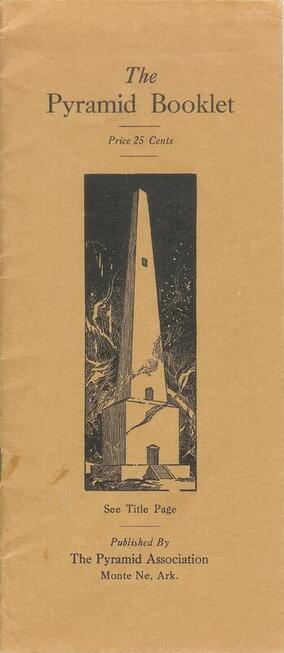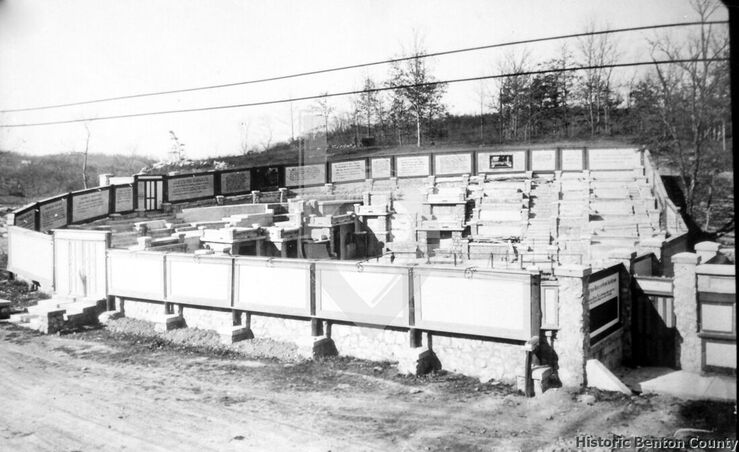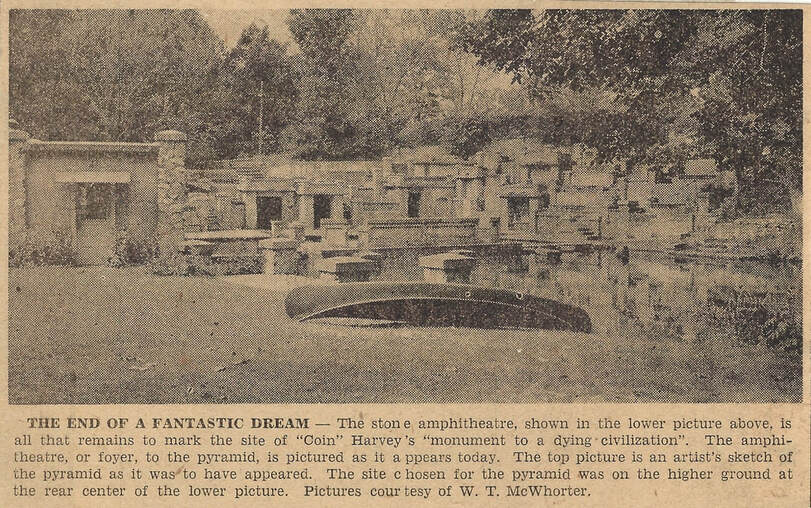Weird Structure Built around Big Spring Stands as Evidence of One Of World's Most Unusual Dreams
Article by C. C. Lambert, believed to be from the Rogers Daily News, now the NWA Democrat Gazette
Unknown date, probably 1950s or 1960s
Article by C. C. Lambert, believed to be from the Rogers Daily News, now the NWA Democrat Gazette
Unknown date, probably 1950s or 1960s
Of all the schemes conceived by the brilliant mind of William Hope Harvey, none was more fantastic, or had more appeal to the popular imagination than his "monument to a dying civilization."
Mr. Harvey had spent a lifetime of study of the "money question" and he reached conclusions which led him to the firm conviction that unless the world accepted his panacea, civilization as we know it was bound to perish from the face of the earth.
Mr. Harvey became convinced of the fatalistic fact because for nearly four decades he had expounded his financial doctrines, but a blind and unheeded world rejected his ideas.
He began his monetary reform efforts early in the 1890s and they came into full flower when in 1896 he managed the presidential campaign for the Great Commoner, William J. Bryan, whose main platform was "free silver," or the coinage of silver at a ratio of 16 to 1 with gold.
It was during the campaign that William Hope Harvey, who had published numerous treatises, came out with a booklet entitled "Coin's Financial School." Millions of copies of the book were sold, and it earned for him the nickname "Coin" Harvey, which remained with him until his death.
People by the millions read his doctrine, many of them approved, but when they went to the polls, William Jennings Bryan, the exponent of monetary reform was defeated.
Somewhat perturbed by his first failure, "Coin" Harvey retreated to the Arkansas Ozarks and created what may have been the first summer resort community at Monte Ne, then known as Silver Spring.
Interspersing his financial studies and preachments with the more prosaic business of running a summer resort, "Coin" Harvey continued to issue tracts and pamphlets expounding his monetary theories. But whatever influence he may once have had was long since lost and his ideas found progressively fewer and fewer disciples.
Finally he became convinced that the world was not yet ready for his Utopian monetary reforms. He had offered to show the way. He had blazed the path, but a money-crazed world passed him by.
Surely civilization must perish, because, he theorized, "usury" could lead only to financial ruin.
The legal definition of usury is interest in excess of a legal rate charged to a borrower for the use of money. But "Coin" Harvey preferred to use the word in its obsolete sente, "a premium charged for the loan of money or goods."
Interest, or a usurious charge for the loan of money, could wipe ou all capital, not only of individuals, but of nations as well.
Forsaking all else, "Coin" Harvey started about the middle part of the 1920s to erect his monument to a dying civilization, to be opened by archaeologists some two thousand years hence to find relics of civilization as it existed in the Twentieth century.
In this monument, a gigantic pyramid of cement and stone designed to stand the ravages of time, were to be placed relics, which would give the new civilization a complete picture of life as it exists today.
Appeals were made for contributions and world-wide publicity brought contributions from nearly every civilizated country on the globe. How much money was contributed probably will never be known. But, whatever the amount, it was not sufficent to complete the task.
Mr. Harvey had spent a lifetime of study of the "money question" and he reached conclusions which led him to the firm conviction that unless the world accepted his panacea, civilization as we know it was bound to perish from the face of the earth.
Mr. Harvey became convinced of the fatalistic fact because for nearly four decades he had expounded his financial doctrines, but a blind and unheeded world rejected his ideas.
He began his monetary reform efforts early in the 1890s and they came into full flower when in 1896 he managed the presidential campaign for the Great Commoner, William J. Bryan, whose main platform was "free silver," or the coinage of silver at a ratio of 16 to 1 with gold.
It was during the campaign that William Hope Harvey, who had published numerous treatises, came out with a booklet entitled "Coin's Financial School." Millions of copies of the book were sold, and it earned for him the nickname "Coin" Harvey, which remained with him until his death.
People by the millions read his doctrine, many of them approved, but when they went to the polls, William Jennings Bryan, the exponent of monetary reform was defeated.
Somewhat perturbed by his first failure, "Coin" Harvey retreated to the Arkansas Ozarks and created what may have been the first summer resort community at Monte Ne, then known as Silver Spring.
Interspersing his financial studies and preachments with the more prosaic business of running a summer resort, "Coin" Harvey continued to issue tracts and pamphlets expounding his monetary theories. But whatever influence he may once have had was long since lost and his ideas found progressively fewer and fewer disciples.
Finally he became convinced that the world was not yet ready for his Utopian monetary reforms. He had offered to show the way. He had blazed the path, but a money-crazed world passed him by.
Surely civilization must perish, because, he theorized, "usury" could lead only to financial ruin.
The legal definition of usury is interest in excess of a legal rate charged to a borrower for the use of money. But "Coin" Harvey preferred to use the word in its obsolete sente, "a premium charged for the loan of money or goods."
Interest, or a usurious charge for the loan of money, could wipe ou all capital, not only of individuals, but of nations as well.
Forsaking all else, "Coin" Harvey started about the middle part of the 1920s to erect his monument to a dying civilization, to be opened by archaeologists some two thousand years hence to find relics of civilization as it existed in the Twentieth century.
In this monument, a gigantic pyramid of cement and stone designed to stand the ravages of time, were to be placed relics, which would give the new civilization a complete picture of life as it exists today.
Appeals were made for contributions and world-wide publicity brought contributions from nearly every civilizated country on the globe. How much money was contributed probably will never be known. But, whatever the amount, it was not sufficent to complete the task.
This is a pamphlet about the building of the pyramid during the time "Coin" Harvey was trying to raise funds for the project.
Today these pamphlets are hard to find and seldom come up for sale.
Today these pamphlets are hard to find and seldom come up for sale.
In order to make a secure footing for the pyrimid, "Coin" Harvey first excavated Big Sprng and the surrounding hills near his home and as sort of reinforcement, he built what he preferred to call the "foyer."
The "foyer", which still exists and is open to the public, consists of an unsymmetrical mass of concrete and stone, built in the form of seats, but without any semblance of regular order. His prospectus claimed the foyer had a seating cpacity of 1,000 persons.
The "foyer", which still exists and is open to the public, consists of an unsymmetrical mass of concrete and stone, built in the form of seats, but without any semblance of regular order. His prospectus claimed the foyer had a seating cpacity of 1,000 persons.
This image shows the builting of the "foyer", better known by most of us today as the amphitheatre. They say Mr. Harvey had no plans for the building of this structure, but would instruct his workers each day as to what he wanted done that day.
Once the foyer was completed, it was enclosed by a high board wall, the panels of which carried in large letters quotations from his various writings. The foyer became quite quite a lucrative source of revenue, because of thousands of visitors attracted by the publicity were charged an admission fee to see the fantastic ampitheatre and hear a lecture on financial reform, and the pyramid. Visitors also were given an opportunity to buy from the wide assortment of Harvey literature, always kept conveniently displayed.
Image of the amphitheatre when it had a walls around the outside. If you look closely you can see the writing on the panels.
As time moved on "Coin" Harvey started work on the pyramid, but stopped as soon as a concrete retaining wall was finished.
In 1930 "Coin" Harvey issued a prospectus showing photographs of the foyer and an artist's sketch of the pyramid, in which he said "all preliminary work is now completed and work on the pyramid is in progress." The booklet was offered for sale at 25 cents each, or 10 for $1.
In 1930 "Coin" Harvey issued a prospectus showing photographs of the foyer and an artist's sketch of the pyramid, in which he said "all preliminary work is now completed and work on the pyramid is in progress." The booklet was offered for sale at 25 cents each, or 10 for $1.
A copy of a page from the pamphlet, with the measurements of the pyramid he was planning to build.
Most would agree that this structure is more of a obelisk than a pyramid.
Most would agree that this structure is more of a obelisk than a pyramid.
"Coin" Harvey estimated that for his pyramid to withstand two milieniums of time, it would require about 18,000 sacks of concrete, 30,000 cubic feet of sand, 60,000 cubic feet of gravel and tons of "corrugated steel reinforcement." The total cost of the structure was estimated at $100,000.
The Portland Cement association donated the services of one of its experts to aid in the construction. He visited the scene and made recommendations as to the type and nature of materials which would be needed to resist the elements for so long a period.
On top of the shaft was to have been placed a plate of "the most enduring matal known", with this inscription molded into it:
"When this can be read, go below and find a record of and the cause of the death of a former civilization."
Similar plates were to be placed on the exterior walls of the two vaults and rooms, except "go below" was to be changed to "go within."
In the large room at the base of the pyramid and in the two vaults in the shaft, duplicate copies of a book telling of the rise and growth of this civilization, dangers threatening its overthrow, and a symposium of opinions on the cause of its "threatened impending death'" were to be placed.
The books were to have been printed upon a specially manufactured paper, bound in leather and to contain about 400 pages. Each page was to be covered with a moisture and air-proof transparent plastic to protect both the paper and the ink. These books were to be encased in hermetically sealed glass containers. It was proposed to publish the book for sale, with the proceeds to go into a trust fund "to be used in improving the grounds about the pyramid and the expense of a caretaker."
In addition to the books, each of the spaces was to include books on industry, scientific achievement, with pictures of all inventions and discoveries, as well as pictures of animals and people. Also to be included were the Bible, encyclopedias and histories, both ancient and modern.
Also to be enclosed were many articles in common use from a "needle and safety pin up to a Victrola and automobile."
A key to the English language to aid in translation, "no matter what language is spoken at the time the pyramid is opened." was to be placed in the glass container in each of the rooms.
Once all of these things had been carefully stowed away inside the gigantic monolith, its doors were to be sealed with reinforced concrete and the plates securely bolted in place. Air was to be exhausted from the interior sections during the process of closing.
"It is presumed that a new civilization rising from the ashes of this one." Mr. Harvey said in his booklet, "will rise slowly as this one has, making discoveries gradually as prompted by human reason." The new civilization, he said, "must arrive at a period when steel and dynamite have been discovered by them before they can break into the pyramid."
Continuing, he said, "as the rooms and each vault will contain information of the existence of the other three compartments, if explosion by dynamite destroys the contents of the first room entered, they will use more care in entereing the other three."
It was made clear that "the body of no one will be entombed herein" and that the name of no person would appear on the outside.
Tracing the development of this civilization from its birth "around the Gulf of India," Mr. Harvey reiterated his often-stated declaration that "selfishness has ever, sooner or later, seized control."
The Portland Cement association donated the services of one of its experts to aid in the construction. He visited the scene and made recommendations as to the type and nature of materials which would be needed to resist the elements for so long a period.
On top of the shaft was to have been placed a plate of "the most enduring matal known", with this inscription molded into it:
"When this can be read, go below and find a record of and the cause of the death of a former civilization."
Similar plates were to be placed on the exterior walls of the two vaults and rooms, except "go below" was to be changed to "go within."
In the large room at the base of the pyramid and in the two vaults in the shaft, duplicate copies of a book telling of the rise and growth of this civilization, dangers threatening its overthrow, and a symposium of opinions on the cause of its "threatened impending death'" were to be placed.
The books were to have been printed upon a specially manufactured paper, bound in leather and to contain about 400 pages. Each page was to be covered with a moisture and air-proof transparent plastic to protect both the paper and the ink. These books were to be encased in hermetically sealed glass containers. It was proposed to publish the book for sale, with the proceeds to go into a trust fund "to be used in improving the grounds about the pyramid and the expense of a caretaker."
In addition to the books, each of the spaces was to include books on industry, scientific achievement, with pictures of all inventions and discoveries, as well as pictures of animals and people. Also to be included were the Bible, encyclopedias and histories, both ancient and modern.
Also to be enclosed were many articles in common use from a "needle and safety pin up to a Victrola and automobile."
A key to the English language to aid in translation, "no matter what language is spoken at the time the pyramid is opened." was to be placed in the glass container in each of the rooms.
Once all of these things had been carefully stowed away inside the gigantic monolith, its doors were to be sealed with reinforced concrete and the plates securely bolted in place. Air was to be exhausted from the interior sections during the process of closing.
"It is presumed that a new civilization rising from the ashes of this one." Mr. Harvey said in his booklet, "will rise slowly as this one has, making discoveries gradually as prompted by human reason." The new civilization, he said, "must arrive at a period when steel and dynamite have been discovered by them before they can break into the pyramid."
Continuing, he said, "as the rooms and each vault will contain information of the existence of the other three compartments, if explosion by dynamite destroys the contents of the first room entered, they will use more care in entereing the other three."
It was made clear that "the body of no one will be entombed herein" and that the name of no person would appear on the outside.
Tracing the development of this civilization from its birth "around the Gulf of India," Mr. Harvey reiterated his often-stated declaration that "selfishness has ever, sooner or later, seized control."





